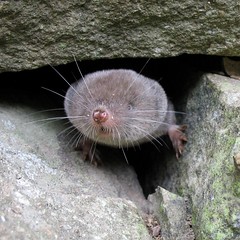 Image by Gilles Gonthier via Flickr Image by Gilles Gonthier via Flickr |
Shrews prefer tunnels that are two to twenty inches deep. They sleep in an underground nest area that is kept clean with a separate section for a latrine. It’s amazing how this small, velvety dark gray, "mouse-like" animal with teeny tiny eyes and teeny tiny legs can be active year-round in mid-Michigan.
 Image via Wikipedia Image via Wikipedia |
Short-tail shrews are also among the very small number of mammalian species that have venom glands. The shrew venom is a neurotoxin that is powerful enough to immobilize or even kill small prey species like mice, moles, salamanders, frogs, all types of insects, slugs, snails, spiders, millipedes and centipedes. The venom can cause swelling and irritation in larger organisms (like humans).
They spend the majority of their life span alone. These solitary little animals will mark their territory with a musky odor to keep other shrews away. And remarkably, because the Northern short-tailed shrews have poor vision, they send out a series of ultrasonic clicks and then listen for the returning echoes. This form of echolocation, similar to what bats and whales use, help the shews detect objects by decoding the echoes and perceive their environment without sight.
 Learn more in the Mammals of Michigan Field Guide
Learn more in the Mammals of Michigan Field Guideby Stan Tekiela (Available at Wild Birds Unlimited East Lansing, MI.)
Or go online to: University of Michigan Museum of Zoology- http://animaldiversity.ummz.umich.edu/site/accounts/information/Blarina_brevicauda.html

No comments:
Post a Comment